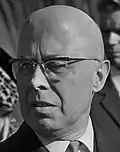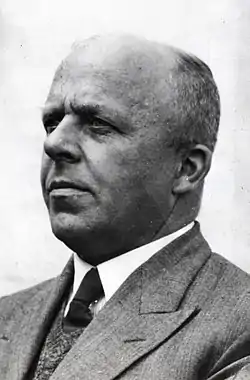Second Drees cabinet Third Drees cabinet | |
|---|---|
45th Cabinet of the Netherlands | |
  First meeting of the cabinet in the Trêveszaal on 2 September 1952 | |
| Date formed | 2 September 1952 |
| Date dissolved | 13 October 1956 4 years, 41 days in office (Demissionary from 13 June 1956) |
| People and organisations | |
| Monarch | Queen Juliana |
| Prime Minister | Willem Drees |
| Deputy Prime Minister | Louis Beel |
| No. of ministers | 17 |
| Ministers removed | 3 |
| Total no. of members | 16 |
| Member party | Labour Party (PvdA) Catholic People's Party (KVP) Anti-Revolutionary Party (ARP) Christian Historical Union (CHU) |
| Status in legislature | Centre-left[1] Majority government (Grand coalition/Roman-Red) |
| History | |
| Election(s) | 1952 election |
| Outgoing election | 1956 election |
| Legislature term(s) | 1952–1956 |
| Incoming formation | 1952 formation |
| Outgoing formation | 1956 formation |
| Predecessor | First Drees cabinet |
| Successor | Third Drees cabinet |
| Part of the Politics series |
![Azure, billetty Or a lion with a coronet Or armed and langued Gules holding in his dexter paw a sword Argent hilted Or and in the sinister paw seven arrows Argent pointed and bound together Or. [The seven arrows stand for the seven provinces of the Union of Utrecht.] The shield is crowned with the (Dutch) royal crown and supported by two lions Or armed and langued gules. They stand on a scroll Azure with the text (Or) "Je Maintiendrai" (French for "I will maintain".)](../I/State_coat_of_arms_of_the_Netherlands.svg.png.webp) |
|---|
|
|
The Second Drees cabinet, also called the Third Drees cabinet[2] was the executive branch of the Dutch Government from 2 September 1952 until 13 October 1956. The cabinet was formed by the social-democratic Labour Party (PvdA) and the christian-democratic Catholic People's Party (KVP), Anti-Revolutionary Party (ARP) and Christian Historical Union (CHU) after the election of 1952. The cabinet was a Centre-left[3] grand coalition and had a majority in the House of Representatives with Labour Leader Willem Drees serving as Prime Minister. Former Catholic Prime Minister Louis Beel served as Deputy Prime Minister and Minister of the Interior.
The cabinet served during early years of the turbulent 1950s. Domestically the recovery and rebuilding following World War II continued with the assistance of the Marshall Plan, it also able to finalize several major social reforms to social security, welfare, child benefits and education from the previous cabinet. Internationally the decolonization of the Dutch East Indies following the Indonesian National Revolution continued. The cabinet suffered no major internal and external conflicts and completed its entire term and was succeeded by the Third Drees cabinet following the election of 1956.[4]
Term
The economic recovery after World War II continued. This made further expansion of social security possible, of which the best example is the institution of the state pension AOW in 1956. Also, a major housing scheme was executed, building 80 000 houses per year.
A major setback was the North Sea flood of 1953, which resulted in damage equivalent to 5% of the GDP. An emergency law was made to recover the dykes and plans were made for the Delta Works, the world's largest flood protection project, which should protect the South West Netherlands against another such combination of storm and spring tide.
An episcopal 'mandement' called for Catholics to give up their PvdA-membership, but without result.
The 29 December 1952 Statute for the kingdom granted Surinam and the Netherlands Antilles a certain degree of independence within the kingdom.
In 1955 the labour ban on married women was abolished, following the "motion Tendeloo", named after PvdA's member of parliament Corry Tendeloo. This ban meant that state employers had to fire their female employees once they married.[5]
On 15 February 1956 the Dutch-Indonesian Union officially ended. Relationships between the two countries continued to deteriorate.
When the PvdA voted with the opposition over a combined law to lower taxes and raise rents on 17 May 1955, this led to a crisis. The cabinet fell, but returned after 17 days when PvdA chairman Burger had reconciled the parties.


%252C_premier_van_Griekenland%252C_ontvangen_door_m%252C_Bestanddeelnr_091-0891.jpg.webp)

Cabinet Members
- Resigned
- Retained from the previous cabinet
- Continued in the next cabinet
- Acting
- Ad Interim
- Died in Office
- Appointed as Chairman of the Special State Commission
Trivia
- Nine cabinet members had previous experience as scholars and professors: Louis Beel (Administrative Law), Julius Christiaan van Oven (Roman Law), Jelle Zijlstra (Public Economics), Willem Kernkamp (Constitutional and Administrative Law and Arabic Literature), Willem Hendrik van den Berge (Public Economics), Gerard Veldkamp (Microeconomics), Piet Muntendam (Social Medicine), Aat van Rhijn (Fiscal Law) and Anna de Waal (Geography).
- Four cabinet members (later) served as Prime Minister: Willem Drees (1948–1958), Louis Beel (1946–1948) (1958–1959), Jelle Zijlstra (1966–1967) and Jo Cals (1965–1966).
- Four cabinet members would later be granted the honorary title of Minister of State: Willem Drees (1958), Louis Beel (1956), Jelle Zijlstra (1983) and Jo Cals (1966).
- Two cabinet members Johan Beyen and Sicco Mansholt are considered Founding fathers of the European Union.
- The age difference between oldest cabinet member Julius Christiaan van Oven (born 1881) and the youngest cabinet member Gerard Veldkamp (born 1921) was 39 years, 222 days.
- Had both the oldest and youngest cabinet members in Dutch History when they took office: Julius Christiaan van Oven was 74 years, 90 days years old and Gerard Veldkamp was 31 years, 105 days years old.
- Anna de Waal was the first female cabinet member in Dutch History.
References
- ↑ Changing Liaisons The Dynamics of Social Partnership in 20th Century West-European DemocraciesBy Karel Davids, 2007, P.165
- ↑ According to a different numbering this was the Fourth Drees cabinet because it was the third cabinet with Willem Drees as Prime Minister.
- ↑ Changing Liaisons The Dynamics of Social Partnership in 20th Century West-European DemocraciesBy Karel Davids, 2007, P.165
- ↑ "Coalities tussen sociaaldemocraten en confessionelen" (in Dutch). Historisch Nieuwsblad. 10 August 2006. Retrieved 24 April 2018.
- ↑ "Mr. N.S.C. (Corry) Tendeloo". Parlement.com (in Dutch). Retrieved 25 September 2021.
External links
- Official
- (in Dutch) Kabinet-Drees III Parlement & Politiek
- (in Dutch) Kabinet-Drees II Rijksoverheid



.jpg.webp)
.jpg.webp)

.jpg.webp)

.jpg.webp)

.jpg.webp)
.jpg.webp)
.jpg.webp)
.jpg.webp)
.jpg.webp)

.jpg.webp)

.jpg.webp)
.jpg.webp)


.jpg.webp)
.jpg.webp)